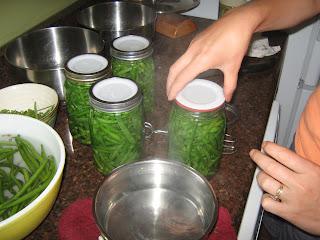The Tattler lids are reusable year after year, are BPA-free, and made in the USA! I really like the idea of using them again and again which reduces waste and is one less thing to buy. There's nothing worse than getting all your supplies on the counter and realize you are two lids short! I purchased a dozen of these narrow mouth lids and bands for $8.00 and wide mouth lids and bands for $10.00 which equates to less than $1.00 per lid. The downside of the Tattler lids is that they are made of plastic, a petroleum product. Without doing a full lifecycle analysis (who has time for that?), I still think the Tattler lids are more sustainable for the fact that they are reusable and the food shouldn't be touching the plastic lid anyway.
I canned 35 quarts of green beans with these lids and they successfully sealed! I still have a stockpile of metal lids that I will save for jams, peaches, applesauce, and tomato soup that I will give away to friends.
Tattler lids are very easy to use. Simmer the lids and rubber rings in water until ready to use and...
Step 1: Place rubber ring on jar rim.
Step 2: Place white cap on top of rubber ring.
Step 3: Screw on metal ring.
I also have two of these old-fashioned jars with the rubber ring and glass lid held together with a metal clasp. These are rare, and if you're lucky, the lid will not have any chips and cracks. In terms of sustainability, I think these would be the number one choice, but the user would need to take extra care with the glass lids and make sure the metal clasps don't rust. Speaking of rust, remove metal clasps and rings when storing. I don't know why people think that if they remove the metal ring, the lid will unseal----remove the ring to keep it from rusting! The rings will last a lot longer this way.
I also discovered another type of jar at The Homestead Supply Company that uses a glass lid and rubber ring held together by metal tabs. These Weck jars are German-made so they use the metric system measurements. Unfortunately these jars can only be used in a boiling water bath which limits what can be preserved.
I always think it's sad to see the beans go from bright green to a dull green after they come out of the canner. A picture of before and after...













3 comments :
Did the green beans come from your garden? If so-you had a great year for green beans!
A lot of what we planted in our garden didn't survive the three weeks of 100+ temperatures in a row this year.
Great tip on removing the rings on the jars after they seal!
Someday when I have space for a larger garden I hope my garden produces this many beans! I usually only get about 5 jars of surplus beans from my garden each summer. Our summer vegetables come from our garden and then I have to purchase our winter supply from surrounding farmers.
I love those little Weck jars. They would make really cute jams for gifts.
I have a few of the old glass lid jars but have had a hard time finding the rubber rings until this year. I think the resurgence of interest in canning has brought back a lot of items I thought were extinct, hooray!
Nice job on those beans, very nicely packed.
Post a Comment